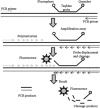Application of quantitative PCR for the detection of microorganisms in water
- PMID: 23001336
- PMCID: PMC7079929
- DOI: 10.1007/s00216-012-6399-3
Application of quantitative PCR for the detection of microorganisms in water
Abstract
The occurrence of microorganisms in water due to contamination is a health risk and control thereof is a necessity. Conventional detection methods may be misleading and do not provide rapid results allowing for immediate action. The quantitative polymerase chain reaction (qPCR) method has proven to be an effective tool to detect and quantify microorganisms in water within a few hours. Quantitative PCR assays have recently been developed for the detection of specific adeno- and polyomaviruses, bacteria and protozoa in different water sources. The technique is highly sensitive and able to detect low numbers of microorganisms. Quantitative PCR can be applied for microbial source tracking in water sources, to determine the efficiency of water and wastewater treatment plants and act as a tool for risk assessment. Different qPCR assays exist depending on whether an internal control is used or whether measurements are taken at the end of the PCR reaction (end-point qPCR) or in the exponential phase (real-time qPCR). Fluorescent probes are used in the PCR reaction to hybridise within the target sequence to generate a signal and, together with specialised systems, quantify the amount of PCR product. Quantitative reverse transcription polymerase chain reaction (q-RT-PCR) is a more sensitive technique that detects low copy number RNA and can be applied to detect, e.g. enteric viruses and viable microorganisms in water, and measure specific gene expression. There is, however, a need to standardise qPCR protocols if this technique is to be used as an analytical diagnostic tool for routine monitoring. This review focuses on the application of qPCR in the detection of microorganisms in water.
Figures




References
-
- Oliver JD. J Microbiol. 2002;43(5):93–100. - PubMed
-
- Farnleitner AH, Mach RL, Burtscher MM, Reischer GH, Ryzinska G, Keiblinger K, Rudnicki S, Knetsch S (2005) In: Proceedings of the 13th international symposium on health related water microbiology, Swansea, 5–9 Sept 2005
Publication types
MeSH terms
Substances
LinkOut - more resources
Full Text Sources
Other Literature Sources

